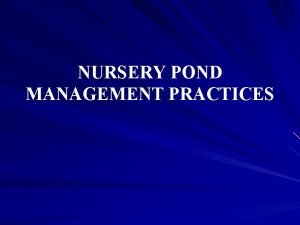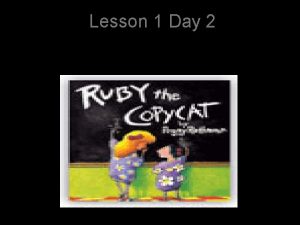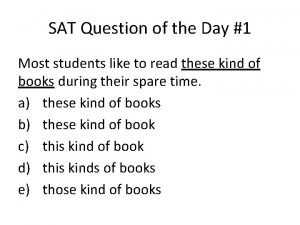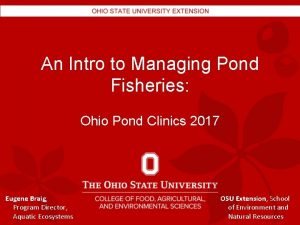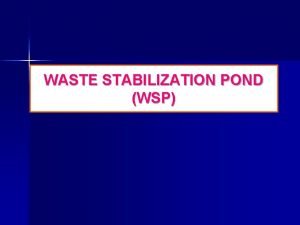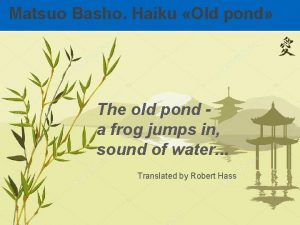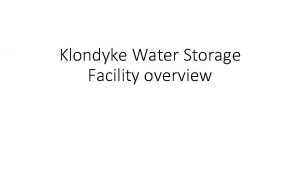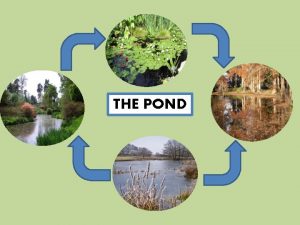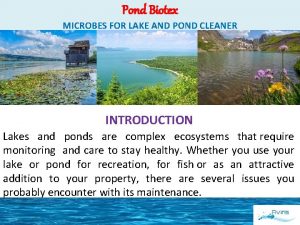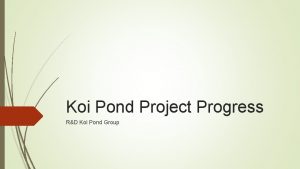Question of the Day A onehectare pond is












- Slides: 12


Question of the Day A one-hectare pond is sampled in early September. The sample yields 1 small catfish, as well as, 17 benthic invertebrates that represent 10 species. If the pond is re-sampled a year later, which of the following would best indicate that the pond had been adversely affected by adjacent development? a. An uncommon species has become more numerous. b. An increase in low-tolerance species has occurred. c. A decrease in high-tolerance species has occurred. d. Phylogenetic diversity has increased. e. The biodiversity of the pond has decreased.

Question of the Day Which of the following is the best illustration of the tragedy of the commons? • a. Depletion of fishing stocks in the North Atlantic • b. Collective farming of wine grapes in communities in France • c. Using national forests for wood production and harvesting • d. Allocation of all nuclear wastes to one site in Nevada • e. Agreements among western ranchers to jointly manage common grazing land

Igneous Rock Magma = the molten, liquid state of rock Lava = magma released from the lithosphere Igneous rock = forms when magma cools Intrusive rock = magma that cools slowly well below Earth’s surface (i. e. , granite) • Extrusive rock = magma ejected from a volcano (i. e. , basalt) • •

Sedimentary Rock • Sediments = particles of rock are blown by wind or washed away by water • Sedimentary rock = dissolved minerals seep through sediment layers and crystallize and bind sediment particles together • Lithification = formation of rock through the processes of compaction, binding, and crystallization

Metamorphic Rock • Metamorphic rock = great heat or pressure on a rock changes its form • Temperatures is high enough to reshape crystals and change its appearance and physical properties • Marble = heated and pressurized limestone • Slate = heated and metamorphosed shale

The Earth has 15 Major Tectonic Plates • Plate tectonics =The idea that the crust consists of large “plates” floating on liquid magma. • Process that produces earthquakes and volcanoes and that determines the geography of the Earth’s surface • Movement of these plates influences climate and evolution of organisms.

Pangea: The Supercontinent • Pangaea = at least twice in Earth’s history, all landmasses were joined in one supercontinent • Continental Drift caused this landmass to break up and form the continents we see today.

Plate Tectonics

Earth’s crust is constantly created and destroyed • Tectonic Plate Boundaries: • Divergent plate boundaries = magma surging upward to the surface divides plates and pushes them apart, creating new crust as it cools and spreads. Responsible for Sea. Floor Spreading • Transform plate boundary = two plates meet, slipping and grinding alongside one another – Friction spawns earthquakes along slipstrike faults – Ex. San Andreas Fault

Tectonic Plates Can Collide • Convergent plate boundaries = where plates collide • Subduction = one plate of crust may slide beneath another – Magma erupts through the surface in volcanoes • Two colliding plates of continental crust may lift material from both plates – Resulted in the Himalaya and Appalachian mountains

 Day 1 day 2 day 3 day 4
Day 1 day 2 day 3 day 4 Nursery pond in fish farming
Nursery pond in fish farming Level three questions
Level three questions Day 1 day 2 day 817
Day 1 day 2 day 817 Contoh open ended question adalah
Contoh open ended question adalah Examples of compelling questions
Examples of compelling questions Example of factor isolating questions
Example of factor isolating questions Question words present simple
Question words present simple Indirect questions examples
Indirect questions examples Clearinghouse probe
Clearinghouse probe Compelling question vs supporting question
Compelling question vs supporting question 1 day 1 question
1 day 1 question Sat question of the day
Sat question of the day

